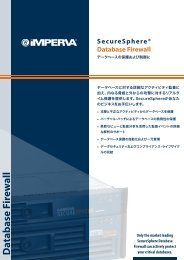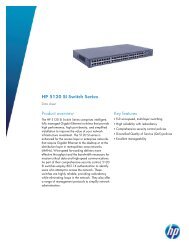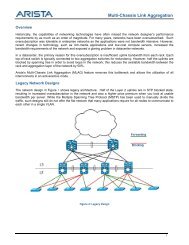Virtual Extensible LAN (VXLAN) Overview VXLAN Use ... - tecnologika
Virtual Extensible LAN (VXLAN) Overview VXLAN Use ... - tecnologika
Virtual Extensible LAN (VXLAN) Overview VXLAN Use ... - tecnologika
Create successful ePaper yourself
Turn your PDF publications into a flip-book with our unique Google optimized e-Paper software.
VTEPs on other hosts receive the multicast frame and process them much the same way unicasttraffic is (see note 2 above).The implementation of this tunneling scheme is relatively simple compared to other schemes, such asMPLS or OTV, because the administrator only needs to configure VNI or IP mappings and multicastaddresses. The rest is managed by the VTEPs.Here are additional details of the frame format:VX<strong>LAN</strong> header formatEthernet header:Destination address - This is set to the MAC address of the destination VTEP if its on the samesubnet. If the VTEP is on a different subnet the address is set to the next hop device, usually a router.V<strong>LAN</strong> -This is optional for a VX<strong>LAN</strong> implementation. It will default to the 802.1Q Tagged PrototocolIdentifier (TPUD) Ethertype 0X8100 and has an associated V<strong>LAN</strong> ID tag.Ethertype –This is set to 0X0800 to denote an IPv4 payload packet. There’s currently no IPV6 supportyet but it’s under investigation future deployment.IP Header:Protocol –This is set to 0 ! 11 to indicate it’s a UDP packet.Source IP –This is set to the VTEP source IP addressDestination IP – This is set to the destination VTEP IP address. If unknown/unlearned or is abroad/multi-cast address, then VX<strong>LAN</strong> simulates a network broadcast using its multicast group. Here’s abrief outline:a) Destination IP is replaced by the IP multicast group that corresponds to the VNI of the sourcevirtual machine.b) Frame is multicast and All VTEPs on the VNI multicast group receive the frame. They in turnunbundle the frame, learn the source ID and VNI mapping for future use and then forward or dropthe packet based on the frame type and local forwarding table information.c) The VTEP hosting the target virtual machine will encapsulate and forward the virtual machinesreply to the sourcing VTEP.d) The source VTEP receives the response and also caches the ID and VNI mapping for future use.UDP header:Source Port -Set by transmitting VTEP. This value can be hashed from the bundled Ethernet headersso that port channel or ecmp hashing algorithms can leverage this value for traffic balancing.www.aristanetworks.com 4










